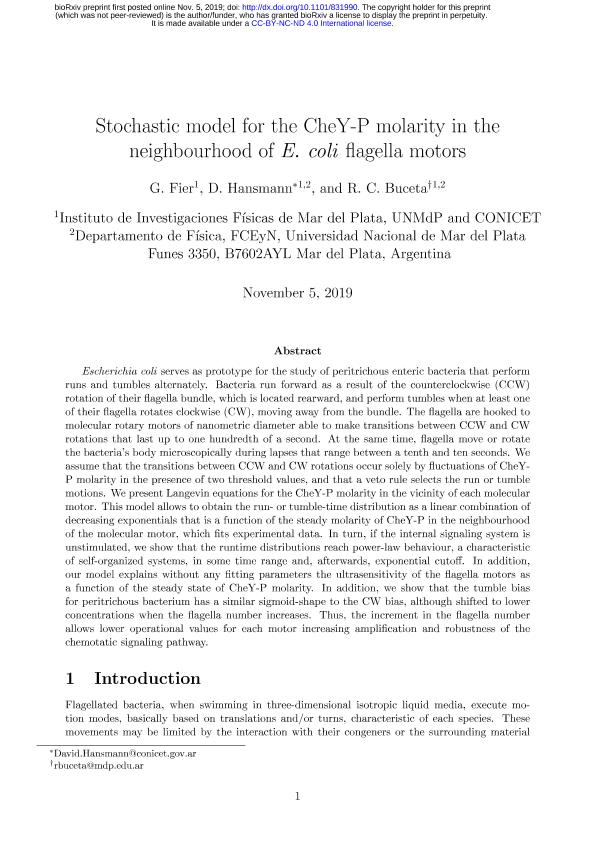Artículo
Stochastic model for the CheY-P molarity in the neighbourhood of E. coli flagella motors
Fecha de publicación:
11/2019
Editorial:
Cornell University
Revista:
bioRxiv
ISSN:
2331-8422
Idioma:
Inglés
Tipo de recurso:
Artículo publicado
Clasificación temática:
Resumen
Escherichia coli serves as prototype for the study of peritrichous enteric bacteria that perform runs and tumbles alternately. Bacteria run forward as a result of the counterclockwise (CCW) rotation of their flagella bundle, which is located rearward, and perform tumbles when at least one of their flagella rotates clockwise (CW), moving away from the bundle. The flagella are hooked to molecular rotary motors of nanometric diameter able to make transitions between CCW and CW rotations that last up to one hundredth of a second. At the same time, flagella move or rotate the bacteria’s body microscopically during lapses that range between a tenth and ten seconds. We assume that the transitions between CCW and CW rotations occur solely by fluctuations of CheY-P molarity in the presence of two threshold values, and that a veto rule selects the run or tumble motions. We present Langevin equations for the CheY-P molarity in the vicinity of each molecular motor. This model allows to obtain the run- or tumble-time distribution as a linear combination of decreasing exponentials that is a function of the steady molarity of CheY-P in the neighbourhood of the molecular motor, which fits experimental data. In turn, if the internal signaling system is unstimulated, we show that the runtime distributions reach power-law behaviour, a characteristic of self-organized systems, in some time range and, afterwards, exponential cutoff. In addition, our model explains without any fitting parameters the ultrasensitivity of the flagella motors as a function of the steady state of CheY-P molarity. In addition, we show that the tumble bias for peritrichous bacterium has a similar sigmoid-shape to the CW bias, although shifted to lower concentrations when the flagella number increases. Thus, the increment in the flagella number allows lower operational values for each motor increasing amplification and robustness of the chemotatic signaling pathway.
Palabras clave:
STATISTICAL PHYSICS
,
BIOPHYSICS
Archivos asociados
Licencia
Identificadores
Colecciones
Articulos(CCT - MAR DEL PLATA)
Articulos de CTRO.CIENTIFICO TECNOL.CONICET - MAR DEL PLATA
Articulos de CTRO.CIENTIFICO TECNOL.CONICET - MAR DEL PLATA
Articulos(IFIMAR)
Articulos de INST.DE INVESTIGACIONES FISICAS DE MAR DEL PLATA
Articulos de INST.DE INVESTIGACIONES FISICAS DE MAR DEL PLATA
Citación
Fier, Guido; Hansmann, David; Buceta, Ruben Carlos; Stochastic model for the CheY-P molarity in the neighbourhood of E. coli flagella motors; Cornell University; bioRxiv; 11-2019; 1-13
Compartir
Altmétricas




